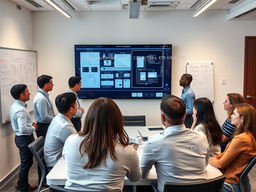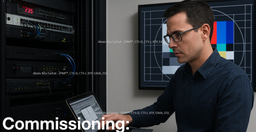Smart Homes: Integrating AV Systems with Home Automation

Related Content
Microsoft
The request is blocked.
The concept of a smart home has evolved rapidly in recent years, driven by the integration of advanced AV systems with home automation technologies. This fusion enhances convenience, energy efficiency, personalization and flexibility, making everyday living more intuitive and responsive. By combining AV systems, such as multi-room audio, home theaters and streaming devices, with home automation controls for lighting, climate and security, modern homes have become sophisticated ecosystems designed to adapt to the needs of their occupants.
I will try to list some of the benefits, challenges and solutions involved in creating smart homes where AV and automation systems coexist harmoniously, ultimately delivering a seamless living experience.
A- Key Benefits of Integration
- Unparalleled Convenience
At the heart of smart home integration is convenient. Home owners can control all connected devices through centralized platforms, whether via mobile apps, voice assistants like Amazon Alexa or Google Assistant or touch panels strategically placed around the home.
Imagine arriving home after a long day and activating a “Relax Mode” with a single voice command. The lights dim, curtains close, temperature adjusts and soft music plays in the background. Such scenarios are possible because AV systems and home automation work in unison, responding to pre-programmed settings that enhance comfort and ease.
- Energy Efficiency
Smart homes contribute to energy efficiency by automating device usage. For instance:
- AV systems and lights can be programmed to turn off automatically when no one is in the room.
- HVAC systems can adjust based on occupancy, optimizing heating or cooling only where needed.
- Intelligent lighting systems can dim or brighten based on natural daylight, reducing energy waste.
This level of automation not only lowers utility bills but also reduces the environmental footprint of the household.
- Personalized Experiences
Integration allows for tailored experiences that cater to individual preferences. Multi-room audio lets users play different music tracks in separate rooms or synchronize the same track throughout the home. Similarly, lighting and soundscapes can be customized to create specific moods (scene) whether for a romantic dinner, an energizing workout or a focused study session.
Profiles can also be configured for each household member, ensuring that every interaction with the smart home feels personalized and engaging.
- Enhanced Flexibility
One of the standout features of integrated systems is their flexibility. Families can manage AV content independently in different rooms or coordinate playback across the entire home. For example, parents might watch a movie in the living room while children enjoy music in their bedrooms; all controlled from the same app or interface.
Flexibility extends to scalability as well. Smart home systems can grow with a household’s needs, easily accommodating new devices or features over time.
B-Challenges in Integration
Despite its many benefits, integrating AV systems with home automation presents unique challenges that must be addressed to unlock the full potential of smart homes.
- Device Compatibility
Smart home market is saturated with devices from various manufacturers, each using different communication protocols, such as Zigbee, Z-Wave, Wi-Fi or proprietary systems. Ensuring these devices communicate seamlessly can be a significant hurdle. For example, an AV receiver from one brand may not natively integrate with a lighting system from another, leading to operational inefficiencies.
- Network Stability
Integrated systems rely heavily on robust network infrastructure. High-resolution AV content streaming, multi-room synchronization and real-time automation commands demand significant bandwidth. Any network disruptions can result in lag, poor audio/video quality or even complete system failure, undermining the user experience.
- User Adaptation
Complexity is another barrier. While tech-savvy users may embrace sophisticated setups, others may find it overwhelming. Inadequate training or unintuitive interfaces can prevent homeowners from fully utilizing their systems, leading to frustration and underperformance.
C- Solutions to Overcome Challenges
- Adopting Open Standards
To address compatibility issues, it is crucial to adopt devices that use open standards or widely recognized protocols. Technologies such as HDMI-CEC, IP-based AV systems and communication standards like Zigbee or Z-Wave ensure seamless interoperability. Middleware solutions or centralized hubs can also act as translators between incompatible systems, allowing them to work together harmoniously.
- Investing in Robust Network Infrastructure
A stable and high-performance network is the backbone of any smart home. Key considerations include:
- Wired vs. Wireless: While wireless solutions offer flexibility, wired connections like Ethernet provide greater reliability and bandwidth, making them ideal for high-demand AV applications.
- Mesh Wi-Fi: For wireless setups, mesh Wi-Fi systems eliminate dead zones and ensure consistent coverage throughout the home.
- QoS Settings: Configuring Quality of Service (QoS) on routers prioritizes critical applications, such as AV streaming, over less demanding tasks.
- Simplifying User Interfaces
The success of a smart home system often depends on how intuitive it is to use. Designers should prioritize simplified interfaces, such as touch panels with clear icons and apps with guided setups. Providing onboarding support and user training ensures that homeowners can fully leverage the capabilities of their systems. Voice control and pre-programmed scenes also simplify operations by reducing the need for manual adjustments.
D-The Role of Professional AV Integrators
Achieving a seamless smart home experience requires expertise, particularly when it comes to system design, installation and programming. Professional AV integrators play a critical role in:
- Assessing the homeowner’s needs and recommending compatible devices.
- Designing network infrastructure capable of handling integrated systems.
- Programming unified platforms and automating processes based on the client’s preferences.
- Providing ongoing maintenance and support to ensure long-term reliability.
Their knowledge of industry standards and best practices ensures that smart home systems not only meet but exceed expectations.
E- Real-World Applications:
-
Home Theaters:
Integrated home theaters combine surround sound, 4K projection, automated lighting and motorized blinds into a cohesive system. With a single command, homeowners can create an immersive cinematic experience. -
Multi-Room Audio:
Families can stream music from platforms like Spotify or Apple Music to any room, synchronizing playback or allowing independent control based on preferences. -
Security Integration:
Linking AV systems with security cameras and intercoms enables homeowners to monitor their property and communicate with visitors through connected displays or mobile devices. -
Energy Management:
By analyzing data from sensors and smart devices, integrated systems can optimize energy use, such as adjusting lighting based on natural daylight or setting AV systems to standby when not in use.
F- The Future of Smart Homes:
As technology advances, smart homes will continue to evolve, driven by innovations like artificial intelligence (AI) and the Internet of Things (IoT). These advancements will enable even greater personalization, predictive automation and remote diagnostics, further enhancing the convenience and efficiency of smart living.
Moreover, sustainability will become a focal point, with systems designed to maximize energy savings and minimize environmental impact. Interoperability will also improve as manufacturers adopt universal standards, simplifying integration and expanding the possibilities for connected living.
Finally, Integrating AV systems with home automation transforms houses into intelligent, responsive environments that cater to the dynamic needs of modern living. While challenges such as compatibility, network stability and user adaptation exist, they can be addressed through open standards, robust infrastructure and intuitive design.
This fusion of technology delivers more than convenience, it redefines comfort, personalization and energy efficiency, making smart homes an essential component of the future. With continued innovation and professional expertise, the dream of a truly seamless and intelligent living space is becoming a reality.
-
Xchange Advocates are recognized AV/IT industry thought leaders and influencers. We invite you to connect with them and follow their activity across the community as they offer valuable insights and expertise while advocating for and building awareness of the AV industry.
Recommended Content
LetsTalkAVbyAlexis Series: Episode 4 : Design Begins With People: Engineering AV Systems Around Real End-User Requirements

LetsTalkAVbyAlexis Series : Episode 2: Network & AV Convergence (AVoIP)





Please sign in or register for FREE
If you are a registered user on AVIXA Xchange, please sign in
Can we play, "what's wrong with this picture?"